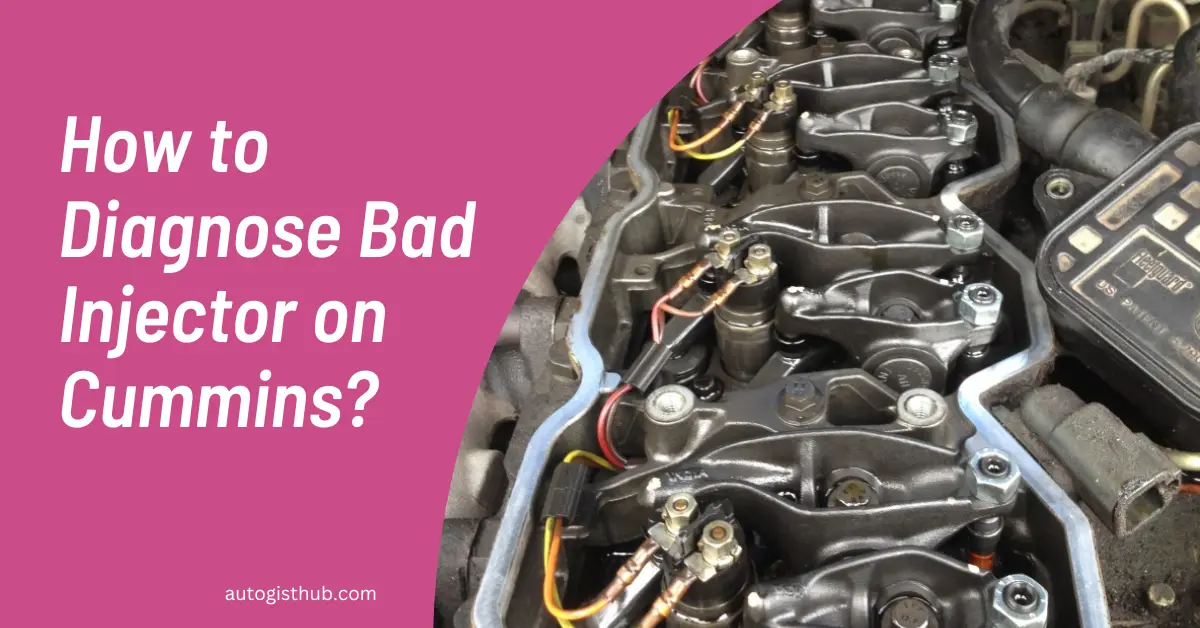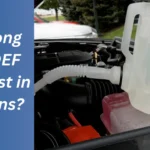To find a bad injector on a Cummins engine, you can use diagnostic tools or perform a visual inspection of the injectors. Additionally, you can check for symptoms such as rough idling, misfires, or excessive black smoke from the exhaust.
Understanding the Symptoms of a Bad Injector
Understanding the symptoms of a bad injector is crucial when it comes to finding issues with your Cummins engine. By recognizing signs like hard starts, misfires, or decreased fuel efficiency, you can quickly diagnose and address injector problems to maintain optimal performance.
Trust your senses and keep an eye out for these telltale signs to identify a faulty injector and prevent further damage.
Rough Idling and Hesitation During Acceleration
If you own a Cummins engine, it’s important to be aware of the symptoms of a bad injector. One of the key signs that your injector may be faulty is rough idling and hesitation during acceleration.
When your injector is not functioning properly, it can lead to an uneven burn of fuel in the cylinder, resulting in a rough and unstable idle. This can create a noticeable shaking or vibrating sensation when your engine is at idle. Additionally, you may experience hesitation or a delay in acceleration when you press the gas pedal.
This occurs because the injector is not delivering the proper amount of fuel, causing a momentary loss of power. If you notice these symptoms, it’s crucial to address the issue promptly to avoid further engine damage.
Excessive Smoke From the Exhaust
Another telltale sign of a bad injector on your Cummins engine is the presence of excessive smoke from the exhaust. When an injector is faulty, it can result in an improper spray pattern or a leaking nozzle, both of which can lead to an excessive amount of fuel being injected into the cylinder. As a result, you may notice thick, black smoke billowing from your exhaust pipe.
This is an indication that the injector is not properly atomizing the fuel, causing an incomplete combustion process. In addition to being a visual annoyance, excessive smoke from the exhaust can also be harmful to the environment and may result in a failed emissions inspection.
Decreased Fuel Efficiency
A bad injector can significantly impact the fuel efficiency of your Cummins engine. When the injector is not functioning correctly, it may not deliver the precise amount of fuel required for optimal combustion. This can result in an inefficient burn, causing your engine to consume more fuel than necessary.
If you notice that your vehicle’s fuel economy has decreased and you find yourself visiting the gas station more frequently, it could be a sign that one or more of your injectors are in need of attention. It’s important to address this issue promptly to not only save money on fuel costs but also to ensure the overall performance and longevity of your engine.
Engine Misfires
Engine misfires are another common symptom of a bad injector on a Cummins engine. An injector that is not operating correctly may not deliver fuel in the precise manner required for proper combustion.
This can result in a misfire, which is when a cylinder fails to ignite fuel at the proper time. Engine misfires can manifest as noticeable jerking or stumbling sensations while driving, accompanied by a loss of power or hesitation. Furthermore, you may hear unusual popping or sputtering sounds from the engine.
In some cases, the check engine light may also illuminate on your dashboard, indicating a misfire detected by the engine control unit (ECU). If you experience any of these symptoms, it’s important to have your injectors inspected and replaced if necessary to avoid potential damage to your engine.
Conducting a Visual Inspection
When it comes to finding a bad injector on a Cummins engine, conducting a visual inspection can be the first step in identifying any potential issues. A visual inspection allows you to examine the injector for any signs of fuel leaks or external damage. By following these steps, you can quickly determine if a bad injector is the culprit behind poor engine performance.
Checking for Fuel Leaks Around the Injector
One of the first things you should do during a visual inspection is to check for fuel leaks around the injector. Fuel leaks often indicate a faulty seal or a crack in the injector body. A fuel leak can result in reduced fuel efficiency and engine performance. To check for fuel leaks:
- Inspect the area around the injector for any visible signs of fuel stains or wetness. Pay close attention to the injector body, fuel lines, and any nearby connections.
- If you notice any fuel stains or wet spots, use a flashlight to get a closer look. Check for any active leaks or signs of recent fuel seepage.
- Make sure to check the fuel injector connections for any loose fittings or damaged seals. These can also contribute to fuel leaks.
Inspecting the Injector for External Damage
In addition to checking for fuel leaks, it’s crucial to inspect the injector for any external damage. External damage can compromise the injector’s performance and lead to issues such as misfires or uneven fuel distribution. To inspect the injector for external damage:
- Visually examine the injector body for any cracks, dents, or signs of physical damage. Pay attention to the injector tip, where damage can often occur due to overheating or corrosion.
- Check for any loose or missing parts, such as screws or bolts. These can indicate that the injector has been improperly installed or has suffered damage.
- Inspect the wiring harness connected to the injector for any frayed or damaged wires. Faulty wiring can cause electrical issues and affect the injector’s performance.
Performing a Cylinder Balance Test
Performing a Cylinder Balance Test is an effective way to identify a bad injector on a Cummins engine. By comparing the balance rates of each cylinder, you can pinpoint the faulty injector and take appropriate action.
Performing a Cylinder Balance Test One effective method to identify a bad injector on your Cummins engine is by performing a cylinder balance test. This test helps you observe the variations in cylinder performance, pinpointing any issues related to your injectors. By utilizing an electronic diagnostic tool for this test, you can accurately analyze the performance of each cylinder.
Let’s dive into the details of how to perform a cylinder balance test and effectively find a bad injector. Using an Electronic Diagnostic Tool for the Test To begin the cylinder balance test, you’ll need to utilize an electronic diagnostic tool specifically designed for Cummins engines. This tool allows you to access crucial data and perform diagnostic actions to identify any potential issues.
It provides real-time information about the performance of each cylinder, enabling you to pinpoint any inconsistencies. To start the test, connect the electronic diagnostic tool to your Cummins engine. Ensure that it is properly connected and powered on. Once connected, initiate the diagnostic mode on the tool and select the cylinder balance test option. The tool will then start analyzing the performance of each cylinder.
Observing Variations in Cylinder Performance During the cylinder balance test, the electronic diagnostic tool will provide you with valuable information regarding the performance of each cylinder. Pay close attention to any variations or abnormalities detected by the tool, as they could indicate a bad injector. The tool will display data such as cylinder pressure, fuel consumption, and injector response time, among others.
Analyze these parameters carefully, comparing them between cylinders. If you notice significant variations in these values, it could indicate that one or more injectors are not functioning properly. Ensure that you take note of any cylinder showing abnormal values or consistent underperformance. These cylinders are potential candidates for having bad injectors.
In Summary Utilizing an electronic diagnostic tool and performing a cylinder balance test is a reliable method to identify a bad injector on your Cummins engine. The tool provides real-time information about the performance of each cylinder, allowing you to pinpoint any variations or abnormalities.
By observing the data and analyzing any inconsistencies, you can accurately detect and address issues related to your injectors. Take note of any cylinders showing abnormal values or underperformance, as they may require further investigation and potential injector replacement. Performing this cylinder balance test ensures you can keep your Cummins engine running smoothly and efficiently, avoiding any potential complications caused by a bad injector.
Conducting a Compression Test
When it comes to diagnosing bad injectors on your Cummins engine, one of the key tests you can perform is a compression test. This test will help you identify any cylinder with low compression, indicating a potential problem with the injector.
Conducting a compression test involves preparing the engine, testing each cylinder, and interpreting the results. Let’s dive deeper into each step:
Preparing the Engine for the Test
Before conducting the compression test, it’s important to ensure that your engine is properly prepared. Follow these steps:
- Ensure that the engine is at operating temperature. This will guarantee accurate compression readings.
- Disconnect the fuel supply to prevent fuel injection during the test.
- Remove all the glow plugs or injectors from the engine. This will release the compression when the test is performed.
Testing Each Cylinder for Compression Readings
Now that your engine is prepared, you can move on to testing each cylinder individually. Here’s how:
- Attach a compression gauge to the first cylinder and make sure it is securely fastened.
- Crank the engine for a few revolutions while observing the compression gauge. This will provide a reading of the cylinder’s compression.
- Repeat this process for each cylinder, recording the compression readings for later analysis.
Interpreting the Results
Once you have completed the compression test, it’s time to interpret the results. Use the following guidelines:
| Compression Reading | Interpretation |
|---|---|
| Equal and high across all cylinders | No issues with the injectors. Move on to other diagnostics. |
| Equal and low across all cylinders | Potential problem with the injector pump or timing. Further investigation is required. |
| Low in one or more cylinders | Indicates a potential problem with the injector(s) in the affected cylinder(s). Consider further testing or inspection. |
By conducting a compression test and analyzing the results, you can successfully identify bad injectors on your Cummins engine. Remember to follow the proper steps for preparing the engine, testing each cylinder, and interpreting the compression readings. This will ensure an accurate diagnosis and help you address any issues promptly.
Analyzing Fuel Injector Solenoid Operation
The fuel injector solenoid plays a crucial role in the overall operation of your Cummins engine. It is responsible for controlling the flow of fuel into the combustion chamber. A faulty or bad injector solenoid can result in various issues such as decreased engine performance, rough idling, and even engine misfires.
Therefore, it is important to analyze the fuel injector solenoid operation to identify any potential problems that may be affecting your Cummins engine’s performance.
Understanding the Role of the Solenoid
The solenoid in a fuel injector acts as an electromagnetic valve that opens and closes the injector nozzle, allowing fuel to be sprayed into the combustion chamber. When the solenoid is energized, it creates a magnetic field that pulls in the injector pintle, opening the nozzle and allowing fuel to pass through.
When the solenoid is not energized, the magnetic field collapses, and the injector pintle closes, preventing any fuel from being injected. This precise control over fuel flow is essential for the efficient operation of your engine.
Using a Multimeter to Check Solenoid Resistance
One way to analyze the fuel injector solenoid operation is by checking the solenoid’s resistance using a multimeter. Here are the steps to follow:
- First, ensure that your engine is turned off and the ignition key is removed to prevent any accidents.
- Locate the fuel injectors on your Cummins engine. They are usually attached to the intake manifold.
- Disconnect the electrical connector from the fuel injector solenoid.
- Set your multimeter to measure resistance (ohms) and connect the test leads to the two terminals of the solenoid.
- Observe the resistance reading on the multimeter display.
It is important to note that the specific resistance values may vary depending on the model and make of your Cummins engine. Refer to the manufacturer’s guidelines or consult a professional if you are unsure about the acceptable resistance range for your particular engine.
Interpreting the Readings
Once you have obtained the resistance readings, you need to interpret them to determine the solenoid’s health. Here are some general guidelines:
| Resistance Range | Interpretation |
|---|---|
| Within the specified range | The solenoid is functioning correctly. |
| Zero resistance or infinity (open circuit) | The solenoid is faulty and needs to be replaced. |
| Resistance significantly outside the specified range | The solenoid may be experiencing an internal issue and further investigation is required. |
It is essential to compare your readings with the manufacturer’s specifications to make an accurate assessment of the solenoid’s condition.
By analyzing the fuel injector solenoid operation and conducting regular checks, you can proactively identify any bad injectors on your Cummins engine, ensuring optimal performance and preventing potential damage to other engine components.
Utilizing Obd-ii Engine Codes
When it comes to diagnosing a bad injector on your Cummins engine, one of the most valuable tools at your disposal is the OBD-II system. This On-Board Diagnostics system provides valuable engine codes that can help in identifying and troubleshooting issues within your engine. By reading and interpreting these codes, you can quickly pinpoint specific problems related to the injector.
Reading and Interpreting Fault Codes
The first step in utilizing OBD-II engine codes to find a bad injector is to read and interpret the fault codes generated by your Cummins engine. The OBD-II system monitors various aspects of your engine’s performance and logs any abnormalities into specific fault codes.
These codes can be accessed using an OBD-II code reader or scanner, which can be easily connected to the OBD-II port of your vehicle. Once you have connected the code reader or scanner, you can retrieve the fault codes stored in the engine’s computer.
These codes are typically alphanumeric and consist of both letters and numbers. Each code corresponds to a specific issue or malfunction within the engine. By understanding the meaning of these codes, you can narrow down the possibilities and focus on the injector-related codes.
Identifying Specific Codes Related to the Injector
In order to find a bad injector, it is crucial to identify the specific codes that are related to the injector. These codes could indicate issues such as injector circuit faults, injector performance problems, or fuel delivery concerns. By filtering out the codes that are unrelated to the injector, you can streamline your diagnosis and pinpoint the exact problem area.
Table: Common OBD-II Codes Related to Injectors
| Code | Description |
|---|---|
| P0201 | Injector Circuit Malfunction – Cylinder 1 |
| P0202 | Injector Circuit Malfunction – Cylinder 2 |
| P0203 | Injector Circuit Malfunction – Cylinder 3 |
| P0204 | Injector Circuit Malfunction – Cylinder 4 |
| P0205 | Injector Circuit Malfunction – Cylinder 5 |
| P0206 | Injector Circuit Malfunction – Cylinder 6 |
Using Code Data to Diagnose the Problem
Once you have identified the specific codes related to the injector, it’s time to use the code data to diagnose the problem. Each code provides valuable information about the nature of the issue, allowing you to narrow down the potential causes.
For example, a code indicating an injector circuit malfunction may point to a wiring or connection problem, while a code indicating an injector performance problem could mean a faulty injector itself. By understanding the meaning behind each code and utilizing the diagnostic information provided, you can take targeted actions to address the problem.
This may involve inspecting the wiring harness, checking the injector’s electrical connections, or even replacing the faulty injector if necessary. With the help of the OBD-II engine codes, you can effectively diagnose and resolve issues related to your Cummins injector, ensuring optimal engine performance and efficiency.
Performing a Fuel Injector Balance Test
When it comes to maintaining the performance and efficiency of your Cummins engine, identifying and addressing issues with the fuel injectors is crucial. A faulty injector can lead to a range of problems, from reduced power and fuel efficiency to rough idling and excessive emissions.
One effective way to diagnose a bad injector is by performing a fuel injector balance test. This test allows you to analyze the differences in fuel injector flow rates, helping you pinpoint any injectors that are not operating at the optimal level.
Connecting a Diagnostic Tool to the Vehicle
Before you can begin the fuel injector balance test, you will need to connect a diagnostic tool to your Cummins engine. This tool will enable you to access the fuel injector control module and obtain the necessary data to conduct the test.
The steps for connecting the diagnostic tool may vary depending on the specific tool you are using and the model of your vehicle. However, in most cases, you will need to follow these general steps:
- Locate the OBD-II port in your vehicle. This port is typically located beneath the dashboard on the driver’s side.
- Plug the diagnostic tool into the OBD-II port. Ensure that the connection is secure.
- Turn on the ignition and wait for the diagnostic tool to establish a connection with the vehicle’s system.
Once you have successfully connected the diagnostic tool to your Cummins engine, you can proceed to analyze the differences in fuel injector flow rates.
Analyzing Differences in Fuel Injector Flow Rates
Now that you have established a connection with the diagnostic tool, you can start analyzing the fuel injector flow rates. This process involves comparing the flow rates of each injector to identify any significant differences that may indicate a problem.
To perform the fuel injector balance test and analyze the flow rates, follow these steps:
- Access the fuel injector control module using the diagnostic tool.
- Select the option to perform a fuel injector balance test.
- Follow the on-screen instructions provided by the diagnostic tool to initiate the test.
- Observe the flow rates of each fuel injector displayed on the diagnostic tool’s screen.
- Compare the flow rates of the injectors and look for any significant differences.
If you notice a substantial variation in flow rates between the injectors, it is likely that one or more injectors are not functioning properly. These injectors may require further inspection or potentially replacement to restore optimal performance.
Performing a fuel injector balance test is an effective method to identify bad injectors in your Cummins engine. By connecting a diagnostic tool and analyzing the differences in fuel injector flow rates, you can pinpoint any injectors that require attention and take the necessary steps to address the issue. Regularly performing this test can help maintain the performance and efficiency of your engine, ensuring a smooth and trouble-free driving experience.
Seeking Professional Help
If you’ve noticed issues with the performance of your Cummins engine, such as rough idling, decreased fuel efficiency, or a loss of power, it could be a sign of a bad fuel injector. While some DIY enthusiasts might be tempted to tackle the problem themselves, seeking professional help from a certified mechanic is often the best course of action.
A qualified technician has the expertise, experience, and tools necessary to accurately diagnose and address injector issues, ensuring your Cummins engine runs smoothly and efficiently. Knowing when to consult a certified mechanic and selecting a reputable service center are essential steps in maintaining the longevity and reliability of your engine.
Knowing When to Consult a Certified Mechanic
Identifying when to consult a certified mechanic for potential fuel injector problems is crucial. Here are some signs that may indicate a bad injector:
- Irregular or rough engine idling.
- Difficulty starting the engine.
- Reduced fuel efficiency.
- Loss of power or acceleration.
- Excessive smoke from the exhaust.
- Foul odors, such as a strong gasoline smell.
If you notice any of these symptoms, it is wise to consult a certified mechanic as soon as possible. Ignoring injector problems can lead to further damage, decreased engine performance, and potentially costly repairs down the line.
Considerations for Choosing a Reputable Mechanic or Service Center
When it comes to finding a trustworthy mechanic or service center for your Cummins engine, there are a few essential considerations:
- Experience and certifications: Look for mechanics or service centers with specific experience and certifications in servicing Cummins engines. This ensures they have the knowledge and expertise required to handle injector repairs effectively.
- Reputation and reviews: Check for online reviews and testimonials from previous customers. Look for consistently positive feedback, indicating a reputable and reliable service provider.
- Availability of diagnostic tools: A reputable mechanic should have access to the latest diagnostic tools and equipment to accurately diagnose and troubleshoot injector issues.
- Warranty and guarantees: Inquire about any warranties or guarantees offered for the repairs performed. A reputable service center will stand behind their work and offer some form of assurance.
- Price transparency: It is important to find a mechanic or service center that is transparent about pricing, providing upfront estimates and avoiding any unexpected or hidden costs.
By considering these factors, you can make an informed decision about the right mechanic or service center to address your Cummins injector issues. Remember, investing in the expertise of a certified professional ensures that the problem is diagnosed accurately and resolved effectively, ultimately prolonging the life of your Cummins engine and maximizing its performance.
FAQs on How to Find Bad Injector on Cummins?
You can determine if Cummins injectors are bad by observing symptoms like rough idling, decreased power and acceleration, excessive smoke, and fuel leaks. Additionally, if you notice a noticeable drop in fuel economy or engine misfires, it may indicate faulty injectors. Regular maintenance and inspections can help identify and address injector issues promptly.
To diagnose a bad diesel injector, look for symptoms such as decreased fuel efficiency, rough idling, black smoke from the exhaust, and engine misfires. You can also conduct a visual inspection for any leaks or damages. However, it’s recommended to seek professional help for accurate diagnosis and repair.
To identify a bad fuel injector, look out for signs like rough idling, misfiring, decreased fuel efficiency, or a strong smell of gasoline. You may also notice engine performance issues such as reduced power or difficulty starting. Consulting a professional mechanic can help pinpoint which specific fuel injector needs replacement.
Conclusion
Identifying a bad injector on a Cummins engine is crucial for optimal performance and fuel efficiency. By paying attention to symptoms such as loss of power, rough idle, or excessive smoke, you can troubleshoot and find the culprit injector. Regular maintenance and thorough inspection will ensure the longevity of your engine.
Don’t delay in addressing injector issues to avoid costly repairs and keep your Cummins running smoothly. Stay proactive and keep your engine in peak condition.




